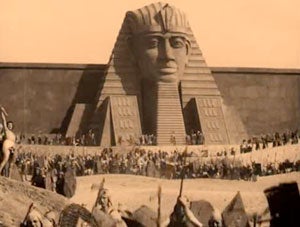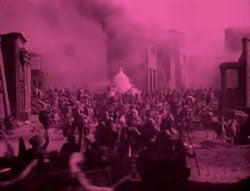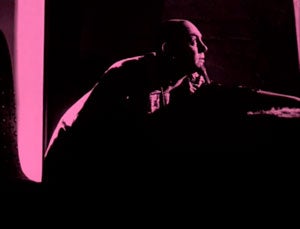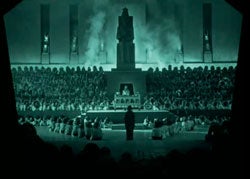On the first day of “The Reel Thing XXVII” in August at the Academy Film Library, participants were treated to a sneak preview of a “work-in-progress,” a 2K digital restoration of The Loves of Pharaoh (Das Weib des Pharao, 1921). Directed by Ernst Lubitsch as an independent production, financed by Paramount, this was to be his second-to-last film before leaving Germany for Hollywood for good. And as Heike Lokke noted in an appreciation after the Pordenone Silent Film Festival screening, The Loves of Pharaoh is “a transitional film for Lubitsch.”

For decades the film was considered completely lost. As late as the mid-1970s, when I wrote my master’s thesis on “Ernst Lubitsch and the Rise of UFA, 1917-1922,” the film was still thought to be an important missing link between his German and American work. Influenced by a previous visit to America, Lubitsch already attempted to cater to American tastes, at least partially, premiering the film in New York in January 1922, a month before its Berlin premiere. In my thesis I quoted the well-known Berlin film and theatre critic, Herbert Ihering:
"…The mass scenes—the preparation for battle, the battle itself, the retreat—are more open, more flowing than in previous Lubitsch efforts. The form has become looser. The lines of movement more lucid. Lubitsch has found in Weib des Pharao the balance between repose and movement: the most important condition for cinema."
But before I comment on the new reconstruction, which allowed me to see the film as if for the first time, I want to relate the exciting path of archival discovery that lead to an almost complete version.
My predecessor at the Munich Flmmuseum, Enno Patalas, first hunted down a Russian version of the film and purchased a print from Gosfilmofond, which he reedited according to a surviving script from Lyda Salmonova, who, like her husband Paul Wegener, was one of the film’s stars. He also added original German intertitles, documented in the German censorship cards, as well as long explanatory titles to fill the narrative gaps. But more than 40% of the film was still missing. I first saw this version in 1977 at a film conference organized by Patalas in Munich.

While many of the mass scenes were there, the images alone were unable to create narrative sense. Then in 1998, Paolo Cherchi Usai, my successor at George Eastman House, acquired the nitrate film collection of Roberto Pallme, a Neapolitan film lover who over the years amassed an important collection of 35mm nitrate and 9.5mm prints. Included in the cache was a 30-minute fragment of an Italian version of Weib des Pharao. According to Thomas Bakels, the digital restorationist at Alpha Omega in Munich, who has guided the project almost from its inception, the footage complimented the existing footage like a clasped hand with only 10% overlap. In fact, all the romantic scenes between the young lovers had been cut from the Russian version, obviously in the interest of increasing revolutionary fervor in remaining scenes of a people in revolt. The Italian version had all the tortured love scenes. Why doesn’t that surprise me?
A 16mm reduction of outtakes then turned up in Berlin, which added a good handful of usable shots, though of visibly poorer image quality. Here we see the limits of present digital restoration technology. No matter how good it has gotten, it can't fix what isn’t there. Finally, an even smaller nitrate fragment found in a foreign archive yielded an original German intertitle, allowing for the faithful reconstruction of typeface and design.
Except for some digital touches, that version was shown at the Giornate del Cinema Muto in 2005 with a live score. The present digital version features newly recorded music of the original score by Erich Künneke, orchestrated by German contemporary composer Frank Strobel.

Some critics complain the acting is exaggerated in the German style, but I believe what Lubitsch crafted was a mass cinema epic interwoven with a Kammerspiel, an expressionist melodrama of three interconnected family units. Expressionist acting demanded stasis, expressing pure emotion through gesture. The stars represented the cream of Max Reinhardt’s Berlin theaters. Jannings plays Pharaoh cruel, then as a lovesick puppy, much as he played The Blue Angel nine years later. Paul Wegener, who specialized in the Other more than once appears in blackface as the Ethiopian King, as does his real-life wife, Lyda Salmonova, playing his girls-gone-wild daughter. Dagny Servaes morphs from a Greek slave girl to the Queen of Egypt. Finally, Albert Bassermann (seen two decades later in a key role in Hitchcock’s Foreign Correspondent) is Pharaoh’s architect, while Pharaoh's son is played by Harry Liedke, who at 40 was a bit beyond playing the romantic hero. Not surprisingly, he gets rescued by the heroine and it is she who chooses him as her King.
In the end, no one gets what they want; despite the hand-wringing, the romantic leads finally consummate their love at the moment they are stoned to death, an expression of the vox populi. Like the highly stylized intimate scenes of family melodrama, the mass scenes of crowds moving to and fro were choreographed with mathematical precision. As Ihering wrote, “repose and movement.”

The monumental sets and cast of thousands (clearly visible on screen) possibly influenced Cecil B. DeMille to make The Ten Commandments (1923), both films becoming benchmarks for establishing the genre of sword-and-sandal epics. I do admit the romantic heroine was a bit too earthy for my taste, but I was fascinated by all the male leads who manifest what psychoanalytically-minded film academics have called “male hysteria.” Fathers, sons, lovers and husbands, all are symbolically castrated by the phallic power of a broad shouldered German Hausfrau and the otherness of aggressive black female sexual desire.






 Mobile Navigation
Mobile Navigation

